Messaging Report
The Messaging Tab provides detailed insight into all bidirectional messaging activity and delivery performance metrics across channels such as SMS, Email, Push, WhatsApp, and RCS. This section is ideal for tracking message exchange volumes, delivery success, and sender performance.

In addition to the Date Range Filter, it has four distinct sections:
- KPI Snapshots, (Total messages exchanged)
- Traffic by Sender
- Breakdown of Messages Exchanged
- General Data Visualization
- Messaging Log
Dashboard
KPIs
The KPI Snapshots correspond to the period defined in the Show Date Range Filter, and they represent totals for that period exclusively.

- Total Messages: Total number of Messages exchanged from the Platform through all Delivery Channels (SMS, Email, Push, WhatsApp, and RCS).
- Outbound Messages: Total number of SMS, Email, Push, WhatsApp, and RCS messages sent from the Platform.
- Inbound Messages: Total number of SMS, WhatsApp, and RCS messages received by the Platform.
Messages Exchanged
The Breakdown of Messages Exchanged is shown in a table that identifies the messages exchanged by channel type.

The four columns and their description are:
- Channel. Identifies the channel type involved in the engagement. Three channels have the capability of being bidirectional – SMS, WhatsApp, RCS – while the Email and Push channels are only outbound capable.
- Outbound. As in the case of the KPIs before, the Outbound column shows the messages sent by the platform, but in the table, it breaks it down on per per-channel-type basis.
- Inbound. Displays the messages received by the platform, but in the table, it breaks it down on per per-channel type basis. Email and Push channels are excluded since this capability does not apply to those cases.
- Total. Shows the sum of Outbound and Inbound exchanges on a per-channel basis
Additionally, the Outbound, Inbound, and Total column headers can be selected to order the results in increasing or decreasing order.
To analyze the traffic between each sender alongside its respective delivery channel (SMS, Email, Push notifications, WhatsApp, RCS), go to the Traffic by Sender section.
General Data Visualization
The platform provides different types of graphs to visualize data and display statistics on the total messages sent for each delivery channel: SMS, Email, Push Notifications, WhatsApp, RCS.
Under the breakdown table of the Dashboard, you will find two Data Visualization Graphs:
-
Total Messages Line Graph (Timeline)
-
Channel Distribution Pie Chart
Total Messages
This graph displays on a timeline the total number of messages over the selected Date Range and by Channel, identified by a color code legend, SMS, Email, Push, WhatsApp, and RCS, as shown on the top right corner of the graph.
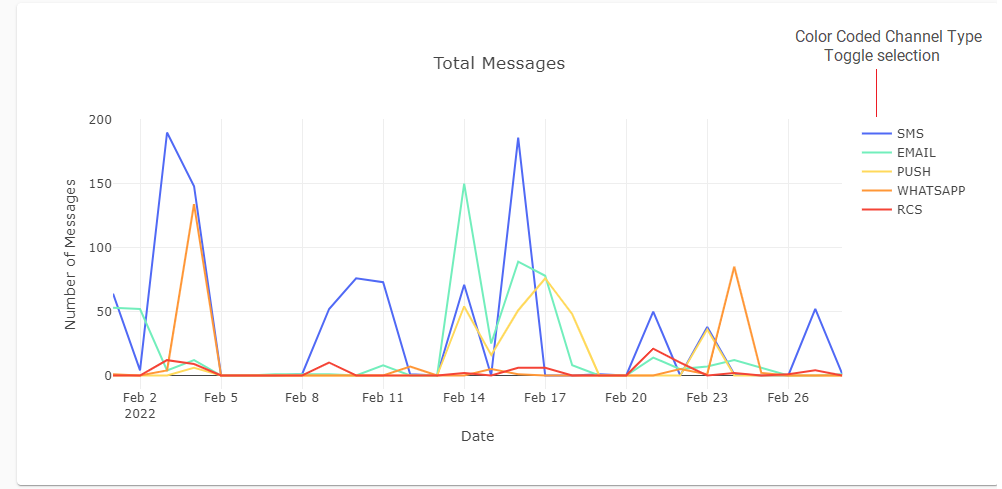
By default, the graph displays all channels. You can isolate specific channels by selecting the channels on the color-coded legend which will toggle them on/off.
The horizontal axis displays the selected Date range and the vertical axis displays the total number of Messages per channel on any given date.
Channel Distribution Pie Chart
The pie chart displays the percentage of messages by channel: SMS, Email, Push, WhatsApp and RCS.
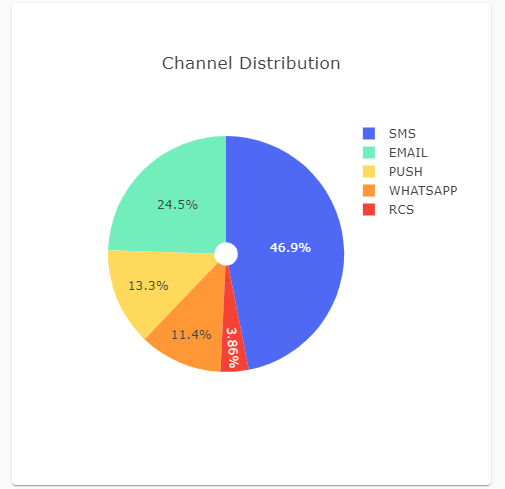
Hovering over the graphs will display additional options, as icons, that can be used with the graphs to identify and enhance the data being displayed.
These are actions associated to each icon:
Messaging Logs
Messaging Logs refer to a detailed and chronological record of all message interactions that occur across the delivery channels, such as SMS, Email, Push Notifications, WhatsApp, and RCS. To know more about the record of each outbound and inbound message, go to the Messaging Logs section.
Traffic by Sender
This section enables you to analyze the traffic between each sender alongside its respective delivery channel (SMS, Email, Push notifications, WhatsApp, RCS).
To enter the Traffic by Sender Dashboard, click the View Details button located next to the date range filter.
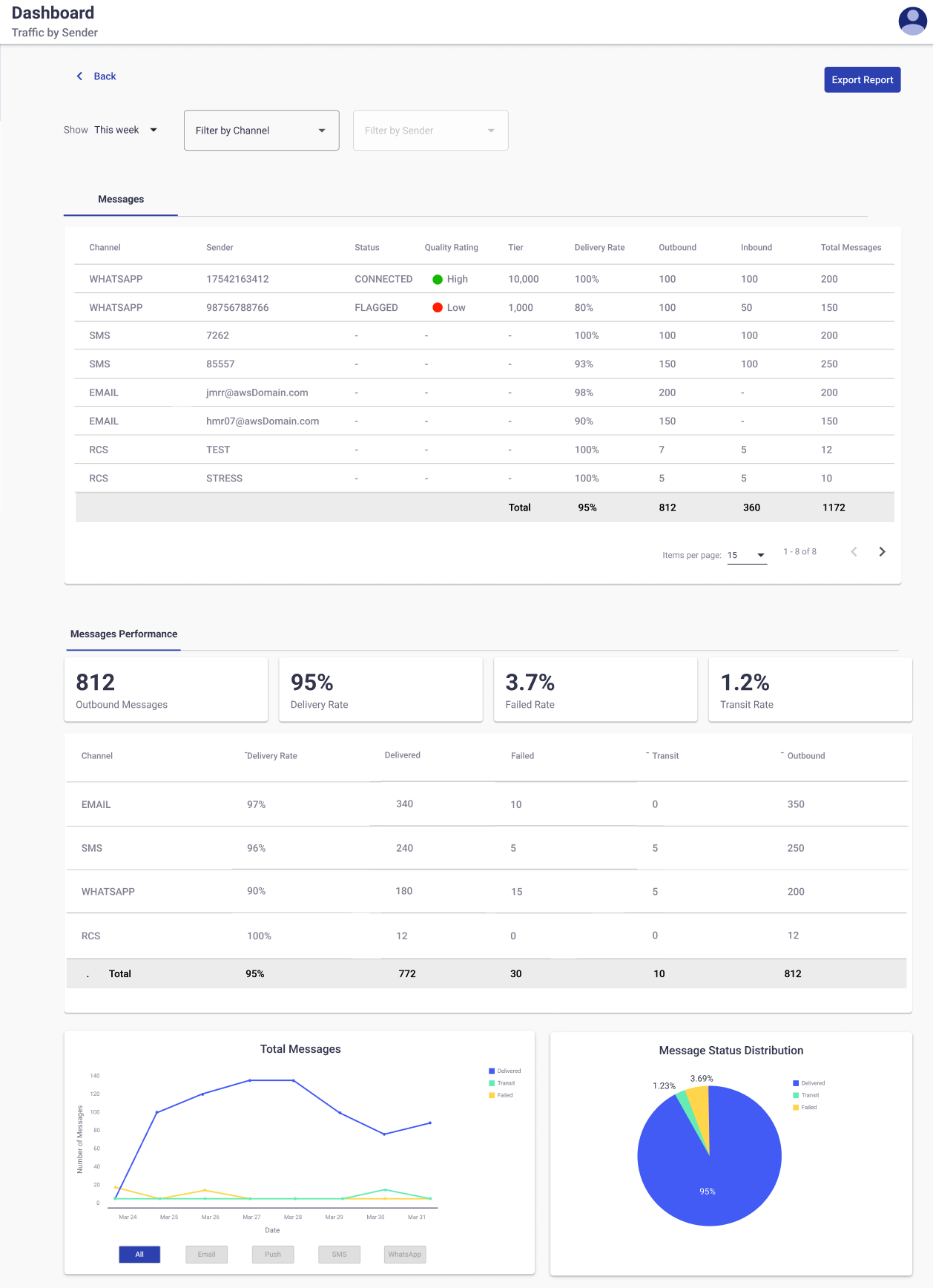
Three tabs allow you to check the overall count of messages sent from each particular sender in both MT (Outbound) and MO (Inbound) directions and their status:
NOTEYou are able to apply three filters in the entire report:
- Date Range -> When selecting the "This Week" option, the date range filter could consider Sunday as the first day of the week, depending on the browser's timezone.
- Filter by Channel
- Filter by sender
According to the filter or filters selected, the report data will be filtered in the three tabs.
Messages tab
The Messages tab displays a table summarizing the number of messages sent (MT), received (MO), and delivery rates per sender and channel. This includes information on the success rate of delivered messages for each sender, too.
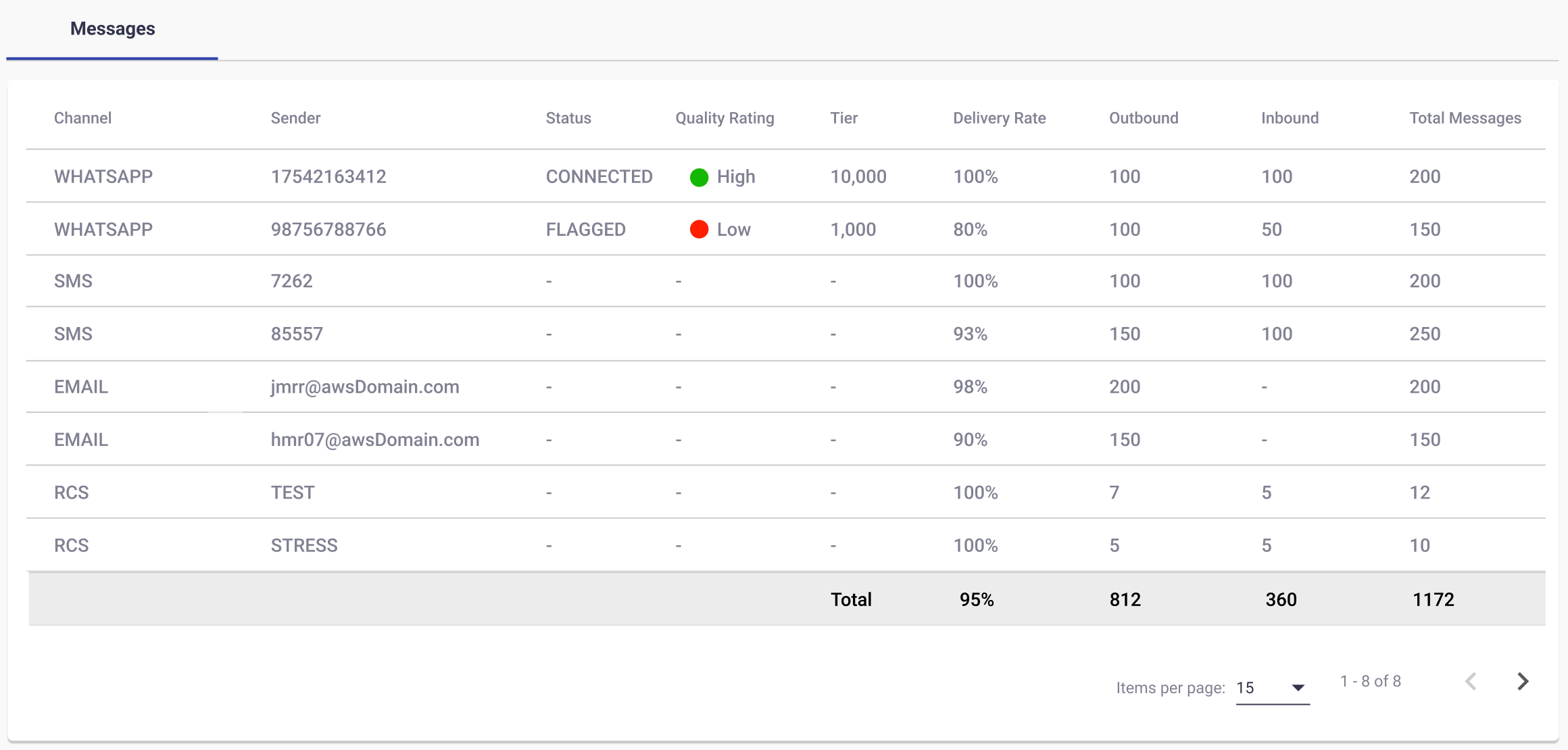
The table consists of the following columns:
Columns | Description |
|---|---|
Channel | Indicates the delivery channel (e.g., SMS, Email, WhatsApp, RCS, Push) used by the sender to send or receive messages. |
Sender | Delivery channel sending identity. |
Status | Indicates the current connectivity state of the sender with the platform. A status of CONNECTED means the sender is actively linked and able to send and receive messages. |
Quality Rating | Reflects the performance level of the sender, based on user engagement and message quality as determined by Meta. A High rating suggests good message delivery performance and user experience. |
Tier | Displays the messaging tier level assigned to the sender, which determines the maximum number of business-initiated conversations allowed per day. For example, a Tier value of 1,000 allows up to 1,000 customer-initiated conversations daily using approved templates. |
Outbound | Total number of messages sent from the platform according to its respective sender. The cumulative total for sent messages is obtained from the Grand Total "Outbound". |
Inbound | Total number of messages received from the platform according to its respective sender. The cumulative total for received messages is obtained from the Grand Total "Inbound". |
Total Messages | Total number of messages that have been sent (outbound) and received (inbound) with their respective sender. The cumulative total for sent and received messages is obtained from the Grand Total "Outbound". |
Delivery Rate |
The cumulative total for total messages that have been successfully delivered is obtained from the Grand Total “Delivery Rate”. |
For a detailed explanation of Tier levels, Quality Rating values, and Status definitions, please refer to the corresponding documentation section: WhatsApp Sender Quality Rating & Status.
NOTEIf a WhatsApp sender has been deactivated or permanently removed from the space, any message data associated with that sender will no longer be retrievable. This means that historical metrics such as Delivery Rate, Outbound, Inbound, and Total Messages will not be displayed in the table.
Even when applying filters by date range corresponding to the sender’s active period, the platform will not display any messaging records linked to a sender that is no longer available.
To preserve continuity in reporting and historical analysis, it is recommended to export relevant data before a sender is decommissioned or removed from service.
Messages Performance tab
The Messages Performance tab provides a detailed visualization and analysis of message delivery outcomes across all delivery channels (SMS, Email, Push, WhatsApp, RCS). It helps you monitor performance metrics, identify delivery issues, and evaluate overall messaging effectiveness.

This section includes three main components:
- KPI Summary (Key Performance Indicators)
- Performance Table
- Data Visualization Graphs
The KPIs located at the top of the Messages Performance tab are the following:

- Outbound Messages: Total number of messages sent through all channels combined.
- Delivery Rate: Percentage of outbound messages that were successfully delivered.
- Failed Rate: Percentage of messages that failed before reaching the recipient.
- Transit Rate: Percentage of messages still pending a final delivery status (e.g., in queue, no coverage, etc.)
This table appears directly below the KPIs and breaks down performance metrics per delivery channel..
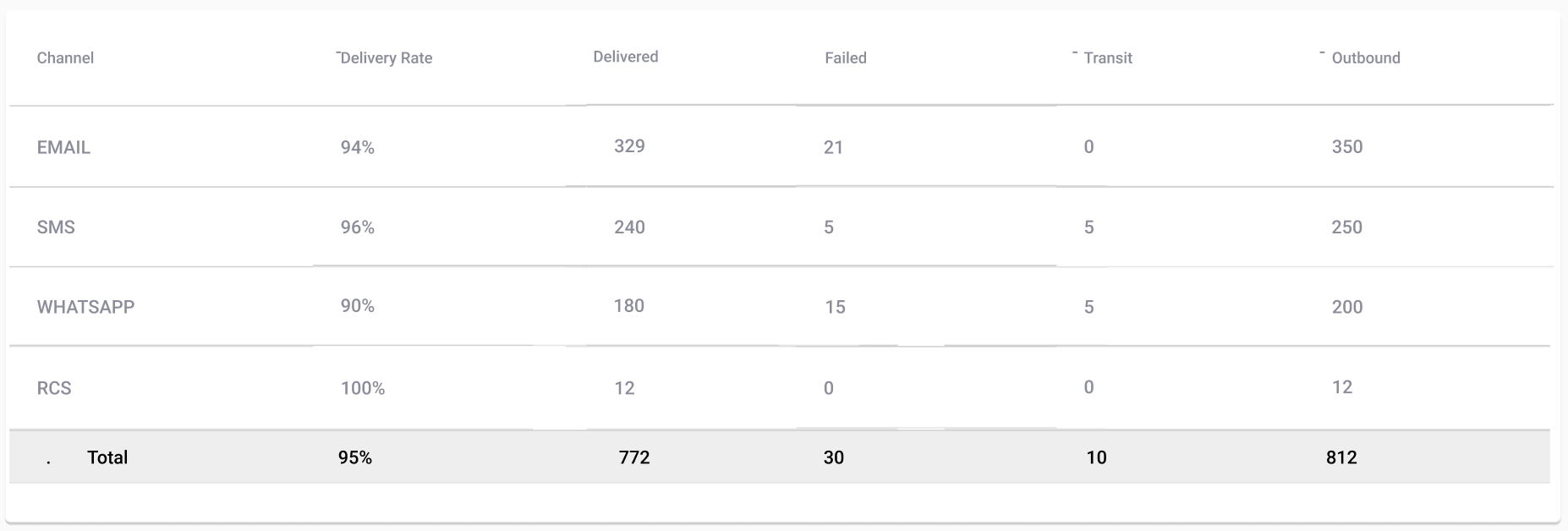
The table consists of the following columns:
Columns | Description |
|---|---|
Channel | Type of delivery channel. |
Delivery Rate | Percentage of the total messages that have been successfully delivered.
|
Delivered | Total number of messages that have been successfully delivered. The cumulative total for sent messages is obtained from the Grand Total "Delivered". |
Failed | Total number of messages that were reported as failed before being delivered. The cumulative total for failed messages is obtained from the Grand Total "Failed". |
Transit | Total number of messages still pending a final delivery status (e.g., in queue, no coverage, etc.) The cumulative total for transit messages is obtained from the Grand Total "Transit". |
Outbound | Total number of outbound messages sent. The cumulative total for sent messages is obtained from the Grand Total "Outbound". |
Below the performance table, two graphs provide visual insight into messaging activity and performance:
-
Total Messages by Status & Channel: This chart displays on a timeline the total number of messages that have been sent (outbound), delivered, in transit, and failed over the selected Date Range and by delivery channel.
Each message status is identified by a color code legend as shown on the top right corner of the graph.

By default, the graph displays all delivery channels and status. To filter specific channels, choose the desired channel you want to filter and click on it . For specific status, select the desired status on the color-coded legend which will toggle them on/off.
The horizontal axis displays the selected date range along with all the delivery channels, and the vertical axis displays the total number of Messages per status on any given date.
- Message Status Distribution Pie Chart: This pie chart displays the overall percentage distribution of messages based on their status: Delivered, Transit, Failed.

WhatsApp Insights tab
The WhatsApp Insights tab provides detailed insights into WhatsApp message metrics associated with the WhatsApp Business Account (WABA) used in the platform.
To access this tab, select the WhatsApp option from the Filter by Channel dropdown.

The WhatsApp Insights tab introduces a reporting view designed to visualize and export message volume and cost data associated with the WhatsApp numbers configured within the Space. This feature enables users to analyze traffic distribution, understand billing references, and access both summarized and detailed insights by country.
WhatsApp messages are categorized into one of the following categories:
-
Authentication: This type of message enables you to authenticate users with one-time passcodes, potentially at multiple steps in the login process (e.g., account verification, account recovery, integrity challenges).
-
Marketing: This type of message includes promotions or offers, informational updates, or invitations for customers to respond or take action.
-
Utility: This type of message facilitates a specific, agreed-upon request or transaction, or updates a customer about an ongoing transaction. These may include transaction confirmations, transaction updates, and/or post-purchase notifications.
-
Service: This category groups all free-form messages exchanged within the 24-hour customer service window that are not tied to a specific template category. It reflects conversational traffic where the business responds to user-initiated inquiries during the service window.
The categories displayed in the report are dynamic. Only categories for which there is traffic and data available for the selected sender and date range will appear. In addition to the standard categories (Authentication, Marketing, Utility, Service), other categories such as Marketing Lite or International Authentication may be shown when applicable to specific countries or traffic conditions. If there is no traffic of that type, those categories will not be displayed in the report.
At the top of the WhatsApp Insights tab, you can filter by date range and WhatsApp sender. Selecting one or both of these filters will modify the data displayed in the table.
The table includes key operational and financial indicators for each WhatsApp number (sender).

The columns displayed in the table are the following:
-
Sender: WhatsApp sending identity (sender).
-
Status: Indicates the current connectivity state of the sender with the platform. A status of CONNECTED means the sender is actively linked and able to send and receive messages.
To know about the WhatsApp Sender status, go to the Status Definitions section.
-
Quality Rating: Reflects the performance level of the sender, based on user engagement and message quality as determined by Meta. A High rating suggests good message delivery performance and user experience.
-
Tier: Displays the messaging tier level assigned to the sender, which determines the maximum number of business-initiated conversations allowed per day. For example, a Tier value of 1,000 allows up to 1,000 customer-initiated conversations daily using approved templates.
-
Authentication, Marketing, Utility, Service: Shows the number of messages sent per category, based on Meta’s classification of conversations and templates.
-
Total Messages: Sum of all message categories during the selected date range for each WhatsApp number (sender).
-
Total Cost: Total estimated cost of messages during the selected date range, expressed in USD or local currency (depending on Meta’s data).
Reference ValuesThe information shown in the report — including message counts and costs — is based on the data reported by Meta and is provided for informational and billing-reference purposes. Values may be updated if Meta adjusts its records, pricing, or billing logic.
-
Details: Provides access to a detailed view segmented by country.
By selecting a specific sender from the summary table, the system displays a secondary table detailing message distribution and costs by destination country.

This view maintains the same column structure and includes the following additional parameter:
- Country: Indicates the destination country of the messages.
The data displayed allows users to analyze how message volumes and estimated costs are distributed across different geographic regions.
For a detailed explanation of Tier levels, Quality Rating values, and Status definitions, please refer to the corresponding documentation section: WhatsApp Sender Quality Rating & Status.
Exporting the Report (CSV)
With the WhatsApp Insights (Full) export, you receive a CSV file with all your WhatsApp volume and cost data, including daily breakdowns by sender, country, and pricing category.
Users with the required permissions can export the WhatsApp Insights report as a CSV file.
How Export Works:
-
The export option is available through the Export Report button located in the upper right corner.
-
Once the Export Report button is clicked, choose WhatsApp Insights under Download report by.

-
Confirm the Email address where you want to receive the file. Click Ok to start the export.
-
Upon request, the system generates the report and sends it automatically to the requester’s email address.
- The CSV file includes both paid and free messages, reflecting the raw data provided by Meta, and is detailed daily.
- Dates are displayed using Coordinated Universal Time (UTC) rather than UNIX timestamps.
- Phone numbers are displayed as plain numeric values, without any additional formatting.
This export enables external analysis, auditing, or integration with internal reporting tools. Therefore, this format is designed for billing, reconciliation with Meta, and external analytics.
Each row in this file represents the volume and cost of messages for a single day, for a specific combination of:
- WhatsApp number (sender)
- Destination country
- Pricing category
- Pricing type (free vs. paid)
The WhatsApp Insights (Full) CSV includes the following columns:

-
start_date & end_date: Represent the 24-hour window for that row. For daily exports, end_date is the day immediately following start_date. Dates are aligned with Meta’s reporting and are in UTC (Coordinated Universal Time).
-
number: WhatsApp phone number (sender) in E.164 format.
-
country: Destination country of the messages. It is expressed as an ISO country code.
-
category: Meta pricing category for the traffic. The categories are dynamic and only appear when there is traffic for that type during the selected date range. If there is no traffic for a given category in the selected period, that category won’t appear in any row.
-
type: Pricing type returned by Meta for that traffic. The most common values are:
-
FREE_CUSTOMER_SERVICE: Free customer service messages within the 24-hour window.
-
REGULAR: Paid traffic for that category.
-
-
volume: Total number of WhatsApp messages. It counts how many messages were sent for that specific day, WhatsApp number, destination country, pricing category, and pricing type. That is, volume tells you “how many messages of this kind were sent on this day to this country from this number".
-
cost: Total estimated cost for the messages in that row, expressed in USD or local currency, according to Meta’s data.
Considerations
When using the WhatsApp Insights report, users must consider the following:
- Time Zone: Meta does not manage time zones. All timestamps are displayed in UTC.
- Data Availability: Meta may impose limits on data access or restrict available date ranges.
- Reference Values: The message counts and costs are derived from Meta’s data and are intended as informative indicators for analysis and billing reference. They may change if Meta updates its underlying data or pricing.
NOTEIf a WhatsApp sender has been deactivated or permanently removed from the space, any message data associated with that sender will no longer be retrievable. This means that historical metrics such as Delivery Rate, Outbound, Inbound, and Total Messages will not be displayed in the table.
Even when applying filters by date range corresponding to the sender’s active period, the platform will not display any messaging records linked to a sender that is no longer available.
To preserve continuity in reporting and historical analysis, it is recommended to export relevant data before a sender is decommissioned or removed from service.
Updated about 1 month ago
